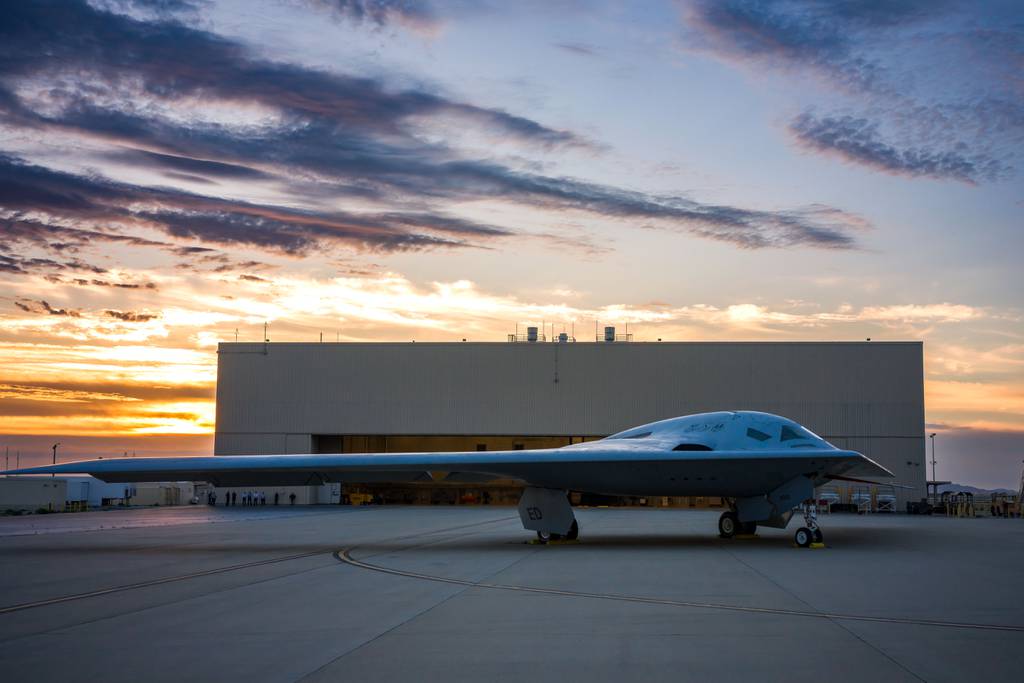NATIONAL HARBOR, Md. — The U.S. Air Force’s next stealth bomber, the B-21 Raider, is conducting engine runs and remains on track for its first flight this year, officials from the service and manufacturer Northrop Grumman said at a conference this week.
The Raider, which the Air Force unveiled in a highly publicized ceremony in Palmdale, California, in December, is in the midst of an extensive series of ground tests for several systems, officials said at the Air and Space Forces Association’s Air, Space and Cyber Conference in Maryland. The testing is required before the aircraft can fly for the first time.
The Air Force intends this new highly classified bomber, which in about a decade will replace the B-1 Lancer and B-2 Spirit, to be a significant new weapon in its arsenal to deter adversaries such as China from acts of aggression. It has significant range and advanced stealth capabilities the Air Force hopes will allow it to slip undetected into enemy territory to carry out penetrating strike missions. The service views it as the “backbone” of its future bomber force.
Air Force Global Strike Command head Gen. Thomas Bussiere said in a Tuesday panel that the Air Force and Northrop Grumman are conducting engine runs to test the B-21′s propulsion systems at Plant 42 in Palmdale, California.
In an interview with Defense News on Wednesday, Tom Jones, president of Northrop Grumman’s aeronautics systems unit, declined to say when the engine runs began or what further tests must occur before the first flight can take place, citing security concerns.
Engine runs are performed with the B-21 restrained in a dock, Jones said, and are meant to ensure the engines are working correctly and responding to the bomber’s throttles. But other prep work done on the Raider in recent months, Jones added, included activating its systems, checking to ensure its control actuation systems work, and ensuring doors and landing gears open or extend properly.
“We’ve made a substantial dent in the work scope that needs to get done in ground check, and we’re very confident we’re going to make the flight this year,” Jones said.

The B-21 team also conducted troubleshooting reviews of the bomber’s fuel systems, William Bailey, director of the Air Force’s Rapid Capabilities Office that oversees the B-21, said in a Wednesday panel. The digital tools used to check the bomber’s fuel infrastructure allowed it to move to the engine run phase in less than five days, he added.
Jones said that on any new aircraft’s development, such checks are crucial to ensuring the fuel moves around to different places as intended.
Even under the best of circumstances, Jones explained, the process can be time-consuming. But if something is faulty, technicians have to get down into hard-to-reach nooks and crannies of the plane to locate the problem and fix it.
“Getting that right is a big deal on any aircraft,” Jones said. “But on a flying wing [such as the B-21], it’s critical to stability.”
Jones said Northrop Grumman has found and fixed things that need to be adjusted or that were installed incorrectly on the Raider during tests such as engine runs, but that those discoveries are part of the normal process of fine-tuning an entirely new aircraft.
He added that investments the company made in digital models and software simulations paid off by helping catch issues and fix them faster, including during fuel checks. And the fact that functional fuel checks were able to take place in just five days showed the B-21′s underlying software is solid, he said.
That software testing is now complete, and only ground tests of its hardware remains, which Jones said is a reversal from how new airplane tests typically work. “Every aircraft that’s ever been made, the airplane has been waiting for the software — at least the ones that have software,” he explained.
In his panel, Bailey joked that the B-21′s software engineers “smack talk” the hardware team, “saying: ‘Would you please hurry up? We’re done.’ ”
The scheduled first flight will take the first bomber to Edwards Air Force Base in California for even more extensive flight tests. It’s taken longer for the B-21 to reach its first flight than its predecessor, the B-2, which had its first flight eight months after its November 1988 rollout.
Jones said the increased complexity of the B-21, including more than 30 years of advancements in technology, led to the longer schedule. But building this first test B-21 as a production-representative aircraft instead of a “bespoke” experimental model — while making things more complicated — will pay off down the road by making it easier to shift into production and leverage economies of scale, he said. For example, the initial B-21 has the mission systems and low-observable stealth coatings all production bombers will have.
“It took a little bit of extra time, [but] it’s going to pay dividends,” Jones said.
In March, Air Force Secretary Frank Kendall sounded a note of caution about the B-21′s first flight, saying it had slipped a few months but was within the baseline schedule.
At the AFA conference this week, Air Force officials such as Kendall, acquisition chief Andrew Hunter and Bussiere expressed satisfaction with the B-21 program. Kendall said he is hopeful the first flight will happen this year, “absent any unexpected surprises.”
“But surprises do happen in acquisition programs,” Kendall added.
Stephen Losey is the air warfare reporter for Defense News. He previously covered leadership and personnel issues at Air Force Times, and the Pentagon, special operations and air warfare at Military.com. He has traveled to the Middle East to cover U.S. Air Force operations.








